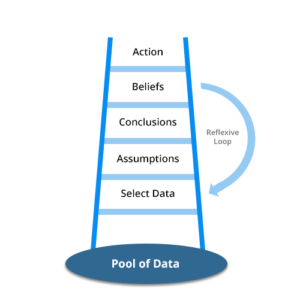
Stepping off the Ladder of Conclusion
A company I worked for were creating standard operating procedures for their workshop and site maintenance employees. A significant contribution had been made by the engineering team in creating the documentation. The project had costed over a hundred thousand dollars in billed hours and consultancy fees however it hit a brick wall and literally stopped.
The reason was that the principal engineer in the organisation did not want the documents to be printed for use by the workshop personnel and those out on site.
His concern was that the documents contained valuable IP and he was not prepared to allow them to end up in the hands of their competitors.
The story was that about 7 years ago a former manager had set up a business in direct competition as a result of his accessibility to the company IP.
Interestingly the company IP was commonly shared, in printed and electronic form, with suppliers who manufactured parts for the company. The principal engineer did not find issue with this.
And so the documents remained in a secure setting untouched for three years.
Does your workplace have someone who makes their mind up and won’t change their views?
These people frustrate others because they seem stuck in the past that no amount of convincing will change their mind, even when you have the facts and evidence that points to a different conclusion to what they expect. They are blind to their opinion being irrational and so you waste so much time trying to change their mind to no avail. The loss to the business can be huge.
How much easier would it be if these people had an open mind and were prepared to listen? It would save so much time and enable the business to be more flexible and adapt quicker.
People react this way usually because the introduction of something new or different causes them to feel threatened or fearful of what might happen. In the principal engineer’s mind he believed that allowing the documents to be printed would lead to another leak of IP.
These reactions occur subconsciously and take less than 0.1 seconds. The speed of the reaction is due to the part of the brain that is activated. It is the old brain that is being activated including the primitive brain; responsible for the fight or flight reaction, and the limbic brain where emotions and memories are located. This area of the brain is our oldest and evolved to protect us as a species. At the first sense of threat, the old brain prepares the body to either fight or to flee. Our response to potential or real threat today is no different to how it would have been thousands of years ago.
Cortisol is the neurotransmitter that is released which prepares the body to fight or flee. Scientists have recently found that cortisol also closes down the higher regions of the brain including the neo cortex; responsible for language and logic, as well as the prefrontal cortex where trust and creativity are located.
With these parts of the brain shut down people only have past memories and experiences to help them make sense of the new information. It is an unconscious reaction they won’t be aware of it happening but it has a profound effect on their behaviour. If the memories are negative, as in the case of the principal engineer, we will have a negative response.
How can you prevent or minimise this occurring in yourself or people you work with?
It comes down to the conversation you have because conflict lies within the story.
When people disagree or refuse to listen is it because of how they have interpreted the situation. They have used assumptions, personal beliefs and reached a conclusion that they strongly hold onto. As you have read earlier, this occurs very quickly.
Ladder of Conclusion
Drawing conclusions quickly is called going up the Ladder of Conclusion. Developed initially by Organisational Psychologist Chris Argyris as the Ladder of Inference, later revised by Peter Senge and recently receiving the backing of scientific evidence through the work of Judith E Glaser, The Ladder of Conclusion is a useful tool to use to see how you and others create individual meaning to the situation.
What does it mean to go up the Ladder of Conclusion?
It means that you have selected some of the data out of what you have heard, applied your own memories, experience, assumptions and beliefs to it, and then reached a conclusion or an opinion that you strongly feel right about. You focus on defending your position which can cause you to become angry, anxious &/or frustrated.
What you can do?
The moment you notice that you have jumped to a conclusion or realised another person has, your best option is to redirect the conversation to why and how the conclusion was made. The intention is to allow space for either you or the person you are talking to, to calm their old brain activity allowing the higher brains to be reactivated.
Questions that you can use on yourself or to help people move down the Ladder of Conclusion include:-
- What has lead you to draw this conclusion?
- What beliefs do you have about the situation?
- What facts have you used? What facts have you disregarded?
- What assumptions are you using?
- When I say ………… what do you understand it to mean?
- What feelings are you experiencing?
The process is logical and conscious. It creates a healthy conversation that leads to outcomes that all parties have contributed to. It allows people to express what they are feeling using a common language and a simple framework. You don’t need a complicated diagram, just a ladder with a few terms.
It is not the topic of the conversation that is the issue; it is how a person feels about it that matters. Effective conversations provide the space to express and share thoughts and feelings. Unfortunately in our time poor workplaces, we forget to provide this hence we end up dealing with miscommunication and misunderstanding.
We assume so much.
Some say its because of the amount of information that is available to us that our brains cannot process it. Instead our we limit this by relying on what we already know and understand. In today’s world, where creativity and flexibility can be the difference between success and failure, this limiting mindset is one to be aware of.
Practice using the Ladder of Conclusion on yourself when you find you are racing up the ladder. Journal your thoughts and seek to identify patterns in your behaviour. This will lead to useful insights that help you remain open rather than fixed and shut down.


